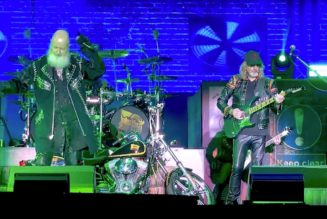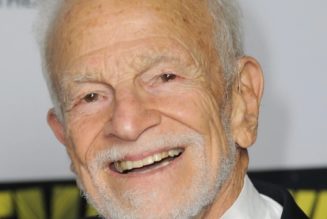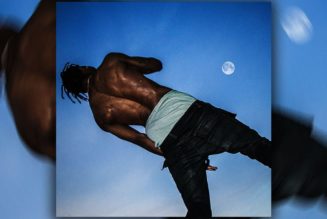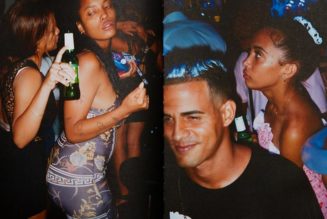One of the things that made Macklemore’s Gaza protest rap “Hind’s Hall” so electrifying when it dropped on May 6 is how unexpected it was. It wasn’t just that Macklemore, who hasn’t really seemed culturally relevant since his notorious Grammy win over Kendrick Lamar a decade ago, was suddenly headline news. It was that no one, relevant or not, seemed to be making protest music anymore, least of all about the Israel-Hamas war.
Macklemore’s blistering anthem takes aim at Israel’s brutal assault on Gaza, where more than 34,000 Palestinians have been killed, following the deadly October 7 Hamas attacks. The song comes at a time when student protests around the country are pushing the conflict and America’s role in it to the forefront of cultural debate. Though Macklemore doesn’t have the reputation for political activism that other artists have, it’s not for lack of trying: He’s been producing politically themed music ever since his debut album in 2005.
Macklemore also occupies a rare position: As he himself says in a “Hind’s Hall” verse, his status as an independent artist, as well as a white one, allows him to take a bold political stance. Most artists would risk career-ending repercussions for speaking out, especially about such a polarized subject as Gaza.
The post-Trump era has been a fallow period for protest music, though the current revival of campus activism could usher in an adjacent revival for the genre. But if “Hind’s Hall” hints at a return, there are other complicating factors at play when we think about what protest music even means in contemporary America.
Macklemore, surprisingly political
“Hind’s Hall” doubles as a song of support for student protesters across America and as a form of protest against Israel’s Gaza offensive itself. The song title refers both to an informally renamed building at Columbia University, the nexus of student protests there, and to the hall’s namesake, Hind Rajab, a 6-year-old Palestinian girl who was allegedly killed by Israeli troops in January, along with her family. The Israeli military also allegedly killed the ambulance crew dispatched to rescue her.
The first verse takes aim at US police and features footage of student demonstrations all across the country where law enforcement was summoned to disperse the mostly peaceful protests. Macklemore also implies that speech on social media has been suppressed: “You can pay off Meta, you can’t pay off me,” he sings, referring to Facebook’s reported censorship of pro-Palestinian views (Meta has denied that claim).
The third verse takes aim at the Gaza conflict itself as well as President Joe Biden’s unwillingness to pressure Israel to change course. “Where does genocide land in your definition?” he asks. “Destroying every college in Gaza and every mosque? Pushing everyone into Rafah and dropping bombs?” — referring to Israel’s military offensive against the city of Rafah, which was supposed to be a safe zone for over a million civilians.
While protest songs experienced a resurgence in the wake of the 2020 Black Lives Matter protests, musical artists have largely stayed silent until now on the subject of Palestine. But while most people know Macklemore mainly from his 2013 hit “Thrift Shop,” a tongue-in-cheek rap glorifying swag finds from Goodwill, he’s not as unlikely a torch-bearer as you might think for this kind of performance.
He’s maintained a surprisingly political catalog, starting with his debut album, 2005’s The Language of My World, which included a track called “White Privilege,” years before the concept of white privilege was well-known within the culture. The song addressed Macklemore’s conflicted feelings on the cultural appropriation of hip-hop by white culture, taking aim at everything from white audiences (“White kids with do-rags trying to practice their accents”) to “controlling” music industry corporations and white artists like himself.
Another track on the album, “Bush Song,” was even more overtly political, mocking then-President George W. Bush for everything from bigoted and sexist politics to the economy and war in Iraq.
Macklemore’s most notable political move prior to “Hind’s Hall” came with 2012’s “Same Love,” a song that advocated LGBTQ equality and criticized homophobia within hip-hop culture. 2016 saw him return to the theme of racism with “White Privilege II,” a track he recorded with Jamila Woods. The track covers themes of racist police brutality and the 2014 Black Lives Matter protests over the killing of Michael Brown, protests Macklemore himself participated in.
Macklemore hasn’t escaped political controversy in the past, including an incident that complicates his decision to speak out on the Israel-Hamas war. In 2014, he wore the world’s most ill-judged costume during a performance, featuring a bulbous prosthetic nose, a black wig, and fake beard. Macklemore at first called the outfit “random” but eventually apologized for its antisemitism. Macklemore says on the track that anti-Zionism is not antisemitism, but it’s difficult to try to be the one to parse the difference when you’ve previously appeared in this kind of stereotypical getup in public.
Still, missteps or not, Macklemore’s status as an independent artist — not to mention a white artist — puts him in a position to take bolder political stances than most artists. Though “Thrift Shop” catapulted him to huge fame, Macklemore primarily used, and still uses, YouTube and social media to reach his core audience. That worked well for “Hind’s Hall,” enabling the track to go viral on Instagram and Twitter before it even landed on streaming services.
Yet that virality might be a double-edged sword. As Vassar musicologist Justin Patch explained, protest music has largely vanished from our modern cultural lexicon, and the advent of social media might be one reason why.
Protest music isn’t what it used to be
We like to think that activism and music have always gone hand in hand, but despite a long legacy of protest music in the US, it’s been decades since we had sustained musical movements of political change and resistance. The ’90s saw plenty of riot grrrls, and the Iraq War generated its fair share of politicized music in response. These days, however, songs like Green Day’s 2004 “American Idiot” or socially conscious rap like Donald Glover’s “This Is America,” 2018’s anti-gun anthem, are rare.
The arguable death knell for protest in pop may have come in 1992, when Ice T’s heavy metal band Body Count released its eponymous debut album, featuring a still-controversial track called “Cop Killer.” The song, which protested racialized police brutality in the era of the police beating of Rodney King, prompted record stores around the country to remove the album from their shelves. It offended law enforcement organizations so much that they successfully pressured Ice T to remove the track and likely influenced Ice T’s label, Warner Bros., to part ways from the rapper at the arguable peak of his success. To this day, authorized versions of the song are difficult to find.
“The early ’90s had a lot of really aggressive protest music, and that’s all gone now,” Patch explained in an interview. “And I think a lot of it has to do with the “Cop Killer” case.” He noted that in addition to Warner Bros. severing its contract with Ice T, several other artists lost their contracts in the wake of “Cop Killer” for similar politically incendiary reasons. The backlash created a chilling effect over the entire industry.
Patch also noted the ongoing homogenization of the music industry, which makes it harder for diverse artists to break through. “We are seeing something that’s vaguely akin to the early ’70s,” he said, “where labels are putting a lot of money behind a small number of artists hoping to get a big return … Labels have a much smaller stable of artists that they want to promote, and that also has to do with radio consolidation as well, where if you get onto one radio station these days, you get onto a hundred radio stations because they’re owned by the same company.” Conversely, that monopolistic landscape means that getting on one company’s bad side can be akin to an industry-wide blackout.
This phenomenon of industry homogenization has happened even as, paradoxically, audience listening tastes are becoming more and more niche. So not only are risk-averse record labels likely to quell too much political activism among their artists, but the diversifying tastes of listeners means “that the political consciousness becomes a lot more difficult to pin down,” as Patch put it.
To a degree, protest music has always been this way. When we think of “protest” music, most people probably think of ’60s-era bands like Buffalo Springfield and Peter, Paul, and Mary singing anti-war anthems and repping a distinctly hippie aesthetic. That may not have been entirely true, Patch argued. “I think the way that the ’60s counterculture is written and talked about is much more monolithic than it was in general,” he said. “And once the realities of something not being monolithic come out, it becomes more difficult to commodify that.”
Patch, who worked in activist spaces throughout the early 2000s, told Vox he feels protest music functions most effectively when it’s part of larger activist infrastructures. “I think that the human element of actually gathering people, I’ve always been more impressed by,” he said.
That’s an element of musical protest that arguably hasn’t really existed since the civil rights and anti-Vietnam movements, when music was an active part of communal resistance. And while American popular music has historically had its share of class-conscious moments, from “Brother, Can You Spare a Dime?” to, well, “Thrift Shop,” modern pop artists have been equally lackluster in responding to ongoing economic and social instability since the 2008 recession. What Patch described as “the apolitical youth music scene” isn’t helping, either.
Are we ready for a new era of musical political activism?
Part of this is down to the rise of social media and our changing social behaviors. “Protest music is there in its ideal form to facilitate types of communication between people and between groups that lead to bigger things,” Patch said. “But that culture of sitting down with people you don’t know and talking through things is not as robust as it used to be. And so we rely more and more on digital connections, which I think are just going to be less nuanced.”
Still, Macklemore does several key things in “Hind’s Hall” that boost its significance. Patch noted that the song’s video editing was a key part of the message, and that his inclusion of the text of the lyrics in the video would further provoke discussion and raise awareness of the points he was making. Though including lyrics text in videos is fairly standard practice nowadays, Patch argued the use is significant in a song about Gaza because audiences can quickly see and then access information about the song’s references.
And crucially, while the modern “sound bite”-style of social media doesn’t exactly lend itself to deep political discourse, it does lend itself to communality. Especially on TikTok, where artists can easily “stitch” their commentary to that of other artists, Macklemore’s effort, as Patch noted, “becomes an opportunity for smaller unsigned artists who are in this underground political music game anyway” to have their messages heard by Macklemore’s audiences, further amplifying political messaging and awareness.
That “Hind’s Hall” exists in a space where it’s doing more digitally than in the real spaces of protest is also a sign, Patch argued, that we need to rethink how we view protest music and what “counts” as activist. In some ways, Patch told me, he’s “hesitant to call” Macklemore’s music “protest.” Patch mused that “Hind’s Hall” may be a step in a different process of creating social change that moves beyond the collective communality of real-world protest into the digital space.
“I think there’s a larger discussion to be had about the private viewing experience and the kind of small-circle socialization that social media is very good at,” Patch said. “Is this still protest or is it something else? At this moment, I think it is something else. And the switch from the analog world to the digital world means we have to develop new vocabularies to try to understand what this is.”








![Rosanne Cash Plans to Record More Music with The National: "I Just Adore Matt [Berninger]'s Voice"](https://www.wazupnaija.com/wp-content/uploads/2023/12/rosanne-cash-plans-to-record-more-music-with-the-national-i-just-adore-matt-berningers-voice-327x219.jpg)